BUSINESS
Restomodding: Business Is Still Booming
Marrying Classic-Car Styling With Modern Performance
By Chad Simon
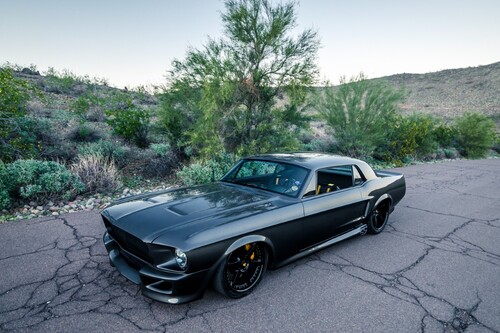
T4 turbos, this ‘68 Ford Mustang Coupe by Tony Arme of
American Legends Hot Rods was a 2018 SEMA Show “Battle
of the Builders” contestant.
The consensus is clear: The transition to electric vehicles is currently underway and will eventually make a hard push into the restomod segment of the industry. Also worth noting, other than some supply-chain issues with getting parts, the COVID-19 pandemic that has plagued the world over the past year and a half has not quenched consumer thirst for wanting to restore classic cars using modern technology.
We spoke with three leaders who specialize in building, customizing and restoring classic vehicles to discover the latest industry trends and what the future holds as well as how the builders established their reputations, source their parts and create partnerships. Here’s what they had to say.
An Exploding Market
While the term “restomodding” might be relatively new, the actual practice has been around ever since hot rodding began, explained Dustin Foust, owner of Classic Restorations, which specializes in ’72 and older domestic vehicles. In the ’50s and ’60s, people put ’60s engines into ’30s cars. Today, the market for a restored and upgraded one-off classic is still strong and constantly expanding.
“It’s something that never decreases in value, so it’s definitely a good investment in a booming industry right now,” Foust said.
If anything, during the pandemic, Foust received more phone calls from people who were stuck at home with a project sitting in the garage, and they wanted to finally do something with it. He noted that now his only real obstacle is getting parts, which is an industry-wide problem. Before the pandemic, lead times were a day or two, but now they’re a week or two and sometimes up to two months.
There aren’t many shops in southeast Indiana, where Classic Restorations is located. The next reputable shop might be 100 mi. away, but the tightly knit restomod community is growing to keep up with demand.
“We’re all friends with each other,” Foust said. “When we see each other at shows, it’s not like they’re our enemy or our competition. There’s more than enough work to go around for everybody. If we find a better way to do something, we share it with each other.”
Tony Arme, owner of American Legends Hot Rods, hasn’t slowed down a bit. He has a backlog of work, which again shows the resilience this market has exhibited over the past couple of years. The business is divided into two: upgrades and repairs, and building cars from scratch—mostly ’60s-era musclecars.
Arme believes that the restomod market and custom-car world are blowing up because it comes down to the personalization and creativity of the car.
“You can see 169 Camaros parked in a lot at a show, and none of them are the same, whereas you go to Cars & Coffee, see 15 McLarens lined up, and it’s just ‘what color do you want?’” Arme said. “In the custom-car world, physically building the cars is so much different than going to a dealership. Everything we do has 10 options—what color this, what part that—and it’s easy to make it your own.”
According to Jeremiah Proffitt, owner of Proffitt’s Resurrection Land Cruisers, the market for a one-off restored vehicle is just as good or better than he can ever remember it being. Other than the aforementioned difficulty in getting some parts, the pandemic hasn’t really affected business.
“Whenever people are uncomfortable with what’s going on around them, they turn to what’s important to them,” Proffitt said. “For many people, automobiles are one of those things they get excited about when they’re unsure of what else is going to happen around them.”
Proffitt—whose schedule is booked 18 months in advance—has met friends and colleagues from all over the world at the SEMA Show, and everybody who’s legit, honest and cares about their customers is busy cranking out cars, according to him.
“If you’re good, know how to add value, and your craftsmanship is at a high level, you’re probably going to be successful,” Proffitt said. “Nobody started in this business because they heard it was the best way to make money. Everybody who’s in this is doing it because it’s a passion. The people who are good at it and can make it over that first hump are experiencing success.”
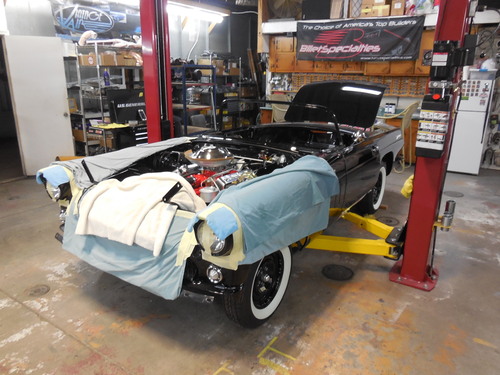
on is a complete factory restoration.
Who Are the Clients?
Foust’s clients are mostly older people who grew up with these types of cars but maybe couldn’t afford one at the time they were new. Now they have the means.
On the other hand, Arme’s customer demographic is all over the place, from their middle 30s to 70s in age.
“We do some stuff for athletes, business owners and retired guys who did well for themselves,” Arme said. “You used to be able to say the trend for a certain car was a specific age group, but we’re seeing some of the older guys build stuff that a younger guy would build and vice versa.”
Proffitt’s clients are mostly 50–65-year-old professionals who have started to free up some room in their budgets to build something they’ve been thinking about building for a long time. His projects are relatively expensive, especially for the 4x4 restomod market, which requires enough discretionary income to spend $100,000 to $200,00 on a car.
“They’re going to use the vehicles, even if they’re just weekend warriors,” Proffitt said. “These clients are not high-end car collectors who are just going to add it to their collections. They usually have a connection to or a memory of a vehicle from their past, and they’re trying to recreate an experience. My grandfather had an FJ40 when I was little; now I want to recreate those memories for my kids and my grandkids, which seems to be a common theme for most of our clients.”
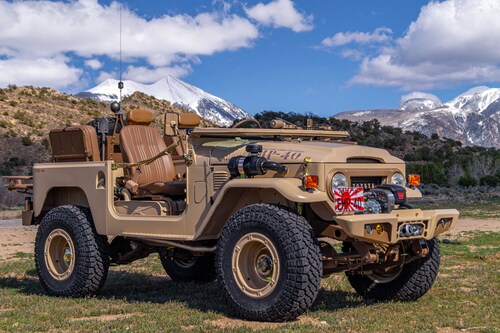
military-themed rig and will be at this year’s SEMA Show.
Latest Trends
According to Foust, everybody loves the lines on classic cars from the ’50s, ’60s and ’70s because they were individual, as opposed to today’s cookie-cutter cars. They want yesterday’s looks with today’s technology, including air conditioning, brakes, suspension and modern fuel-injected engines.
“If you’re used to driving a new car every day and you hop in an old one, you’re going to feel a big difference in performance and how it drives and stops,” Foust said.
Arme believes that people are more interested in convenience—especially with new cars.
“You go to a dealership and buy a brand-new Escalade or Corvette or Camaro, and just some of the amenities that those cars have, how they drive and how foolproof they are, is more or less what our customers are looking for in the old cars, too,” he said.
Many of the higher-end builds are getting modern chassis along with the latest drivetrain platforms and more one-off components. Arme believes that people are drawn to the exclusiveness of having something that nobody else has.
“One of our customers lives in an extremely nice neighborhood,” he said. “You’ll see 10 Lamborghinis driving around on any given weekend, but you’ll never see one of these custom one-off cars, so at some level, it’s about having something that somebody else can’t have. You can’t just go out and get one; it takes us roughly two years to build a car.”
Everybody wants the best of all worlds, according to Proffitt. By combining today’s technology with older vehicles, a ’71 car can be made practical and fun to drive with a higher level of comfort, including better seats, a nicer stereo and instrumentation, more responsive brakes and a more powerful engine.
“We’re capable of higher speeds and also lower [off-road] speeds, more traction and articulation, and better off-road ability,” Proffitt said. “We take everything that everybody has learned about improving automotive function and put it all into one old car, and we end up with something that’s pretty darn cool.”
Over the past five years, Proffitt has seen a push to preserve a vehicle’s value by keeping it closer to the original manufacturer’s DNA or vision but still making improvements within those parameters by using newer components or enhancing the old ones. The clients for those vehicles tend to stay away from LS swaps and other conversions that take the vehicle so far away from its roots. However, that’s not always possible, because sometimes Proffitt has to think outside the box to build what people want. Some want improved drivability with a classic look, while others want to make it look like their vehicle hasn’t been modified until you open the hood or look underneath the chassis.
Then there are those who want to enhance the function of their vehicle for a purpose, such as overlanding, rock crawling or off-roading. Taking those vehicles so far from what the OEM had in mind can destroy their value, but it’s okay because the clients have a vision in their mind of what they want to do with the car, Proffitt explained.
“When I talk to clients, I first find out their goals, what’s important to them, and their long-term vision for the vehicle,” he said. “Then I’ll take them to completely different directions through the build. So if somebody called me and said, ‘My dad bought this Land Cruiser new, and I want it to last another 50 years and continue to appreciate in value,’ then they say they put an LS3 in it, I’d say those two things don’t align. We’re going to take it one way or the other.”
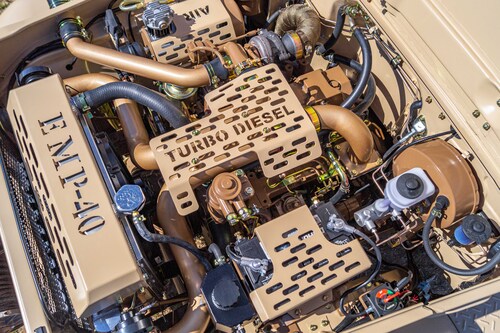
diesel.
Building Connections
Because automotive restoration is a tight-knit community, Foust believes that it’s easy to tell which companies attend shows to help support the industry, and he tries to use those companies whenever possible.
“From doing it for so many years, you learn what companies are good and what companies you don’t like to work with,” he said. “A lot of it is also internet research for certain things that may be outside the box.”
For Arme, sourcing parts is all about repetition. A culture is instilled in the company about how things are supposed to be done, such as using parts they know work so that they don’t have to see a car come back to the shop.
“Doing shows like SEMA, seeing new products released and vendors we use or have used in the past is really where we get some of our ideas,” Arme said. “We just try to use new or innovative products. Depending on what it is, it will push us in a different direction.
“We used to use a gauge company pretty exclusively, and another one came out with some products that we felt were a lot cooler, so we’re now pretty much using only them. I’m not afraid to give somebody a shot if it looks like an amazing product. You’ve just got to try it sometimes to know whether it’s any good or it just looks good.”
Forming business partnerships is a little tricky, according to Proffitt, who concedes that his company struggles with more vendors than those it has success with. Proffitt likes to work with people who know what their products do and how they fit and are willing to offer their support. He said that many of his best relationships were either initially developed and established at the SEMA Show or were nurtured there.
“The companies that think they’re doing us a favor by existing and don’t provide support, we just phase them out,” Proffitt said. “We use companies that are going to take care of us, show an interest in what we’re doing and want to provide both the parts and the service. If we reach out to a company and realize it’s going to be a lot of brain damage to work with and get stuff, we just don’t use it.”
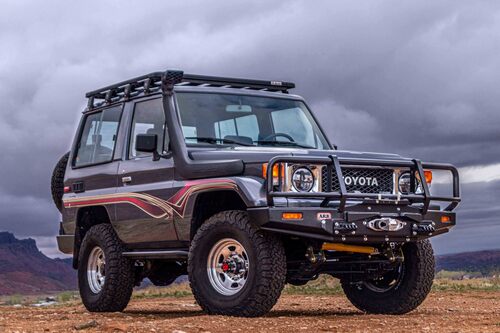
Promoting the Business
Foust doesn’t advertise. Instead, Classic Restorations gets most of its clients via word of mouth and attending shows throughout the country.
According to Arme, his builds market themselves. American Legends Hot Rods has Facebook and Instagram pages to show its work, but having its builds win awards on a national level helps solidify that its cars are well built.
“It’s hard to do in this industry anymore, but we try to do stuff that hasn’t been done before—a different twist on something versus just pulling pages out of magazines and saying, ‘I want that and that and that and that,’ and then trying to puzzle-piece a car together,” Arme said. “A Mustang we did a while back wouldn’t be the first musclecar with a Ferrari engine in it, but stuff like that is more or less what we want to try to do to set us apart from the rest.”
The off-road automobile restoration community is a small world, according to Proffitt. Many clients hear about Proffitt’s Restoration Land Cruisers from chit-chat, either in-person or online, and not as a direct result of any money spent on advertising. The company has a YouTube series called “Proffitt’s Resurrection Land Cruisers TV.”
“It’s a show that we make along the same lines as any automotive restoration show you’d see on the Discovery Channel, except that there’s no deadlines or fake drama,” Proffitt said. “We get out in the shop, talk about the projects, feature the vehicles that we build, and talk to the techs. Almost every serious client I talk to leads off their conversation with, ‘I watched the last three episodes of your show, and now I’m ready to start the project.’ Even though it’s intended to be more entertainment, I think it’s a pretty key marketing element for us, because people get comfortable that we’re not going to steal their money and close up shop or go bankrupt like so many shops do.”
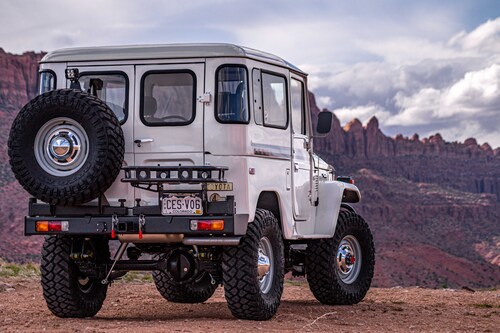
Cruisers is highly custom-parts intensive, set up to be
respectable off-road and awesome on-road.
Looking to the Future
Foust believes that many OEMs will go electric within the next 10 years or so and questions how much longer the internal-combustion engine will last.
“I hope it lasts forever, but I can also see customers wanting to incorporate electric technology into these classic cars,” Foust said. “There are some companies that have already done it, but I can see it becoming more prevalent in the future. With electric motors, everything is instantaneous, and the performance is definitely there.”
He also believes that the biggest obstacle right now to going fully electric is battery technology and where to put them in older cars without losing an entire trunk. According to Foust, the technology will become more widespread once batteries become more compact, user-friendly and easier to change.
The future of restomodding can go many different ways, according to Arme, who also believes that electric cars and even hybrids could become more of a factor.
“We’re looking at doing a hybrid car just to be in on that trend if we need to be,” Arme said. “We don’t want to get left behind on any sort of thing, but the quality and amount of detail that those cars are getting seems to go up every year. The electronics are getting a little fancier as far as what they control, along with the amount of stuff that’s machined out of billet.”
American Legends Hot Rods utilizes 3-D printing, especially for prototyping and making interior components. Arme envisions that along with 3-D printing, CNC machining will also become more standard.
Restomodding will continue to grow, but it’s going to have to change and develop, according to Proffitt. For example, increasing the availability of electric motors and lowering their cost will help to achieve the goal of decreasing emissions; however, people are never going to stop wanting to customize their vehicles.
“The only real question is when are we going to run out of vehicles to build,” he said. “That’s going to be the only thing that could limit what businesses like ours are doing in the future—just finding good-quality, solid vehicles to build in the first place. I don’t think anybody’s going to restore an ’85 Oldsmobile Omega or an ’05 Toyota Camry. At some point, there’s not going to be as much to work on, but I don’t know if it’s going to be in my lifetime or my kids’ lifetimes.”
Proffitt also agrees that electric is the future of mass transit and may one day find its way into both drag and stock-car racing. The enthusiast market for diesel and gasoline engines is still going to be there, and there’s no reason to try to shut them down, according to Proffitt, but gas-powered classic restored vehicles are going to be a very small percentage of the vehicles on the road once there are fewer gas stations and more charging stations.
What’s In the Garage?
Tony Arme, American Legends Hot Rods: “One of the coolest cars we’re doing right now is a ’59 Chrysler 300, which is an extremely rare car. It’s a big old boat with large fins—a typical cruiser-style car—but we’re going to build more of a Pro Touring-style car. We’re removing much of the chrome and doing a lot of stuff that we would do to a high-end Pro Touring musclecar as far as flushing out glass and shaving bits and pieces and kind of refining the whole car. It’s going to be well over 1,000 hp, and it sits on a custom chassis. It’s pretty over the top.”
Dustin Foust, Classic Restorations: “The ’56 Thunderbird we’re working on is a complete factory restoration—all original. The Model T is basically a mechanical restoration. We went through the drivetrain, all the wiring, and put a new interior in it. We also did a 12-volt conversion and added new bearings. The ’39 Ford is a street rod. It’s got a ’11 Mustang drivetrain in it. We’re basically doing all the wiring and electronic stuff. We’ve also got a ’60 Ford Sunliner, which has been a several-year build. It’s got a fully custom twin-turbo Boss 9 engine. We’re actually building it to compete for the Autorama Ridler Award.”
Jeremiah Proffitt, Proffitt’s Resurrection Land Cruisers: “We’re cranking out probably 25 full body-off restorations a year. We have three Cummins R2.8 restomods that are leaving right now. They’re highly custom parts-intensive, set up to be respectable off-road and awesome on-road. Then we have an EMP-hardened FJ40 that we just built for fun. It’s a military-themed rig, but we decided to go overboard on the detail and have it be ‘military chic.’ Lots of yellow, zinc and gold on a tan and brown flat platform with a Cummins Tier 1 diesel and minimal electronics. We call it the EMP40, and it will be at the SEMA Show this year.
“The next one we’re building will set a record for the most expensive Land Cruiser we’ve ever built. It’s a 14-in.-stretched FJ40 with an industrial injection Cummins 4VT.
“One more project that I’m really excited about is a ’61 FJ28 four-door Land Cruiser wagon, of which there are only three in the world. It was restored very poorly, so we’re in the process of disassembling it and finding out all the horrible things that were done to it. But I want to make it something amazing—unlike anything else.”
Sources
American Legends Hot Rods
11002 N. 23rd Ave.
Phoenix, AZ 85029
623-213-7288
https://alhotrods.com
Owner: Tony Arme
Number of employees: 7
Specializes in building and restoring ’60s-era musclecars.
Classic Restorations
6225 Highway 150
Floyds Knobs, IN 47119
812-923-0129
www.classicrestorations-online.com
Owner: Dustin Foust
Number of employees: 3
Specializes in restoring and customizing ’72 and older domestic vehicles.
Proffitt’s Resurrection Land Cruisers
21474 Austin Rd.
Austin, CO 81410
970-596-7363
www.resurrectionlandcruisers.com
Owner: Jeremiah Proffitt
Number of employees: 19
Specializes in building and restoring Toyota Land Cruisers.






